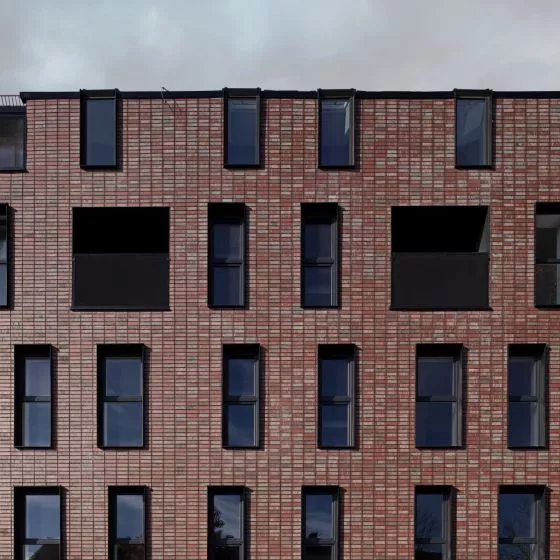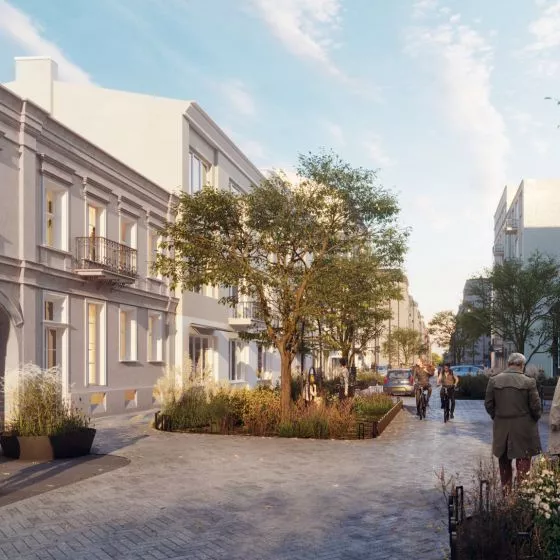The Solpol department store on Wroclaw's main street is stirring up big emotions. Activists want it to be entered in the register of monuments, while others would like to see it demolished.
Solpol was the first department store built in Wroclaw after the fall of communistPoland. It was built in 1993 on Świdnicka Street, which at the time was still a thoroughfare and today is a representative pedestrian zone, just as it was before World War II. The building's investor was Zygmunt Solorz-Zak, now one of the richest Poles and owner, among other things, of Polsat TV. The cost of construction was five million dollars. The department store is located on a plot of land between an Art Nouveau townhouse and Franciszkańska Street, opposite the grand Gothic church of St. Stanislaus and St. Dorothy.
Solpol is located on a plot of land between an Art Nouveau townhouse and Franciszkańska Street, opposite the grand Gothic church of Sts. Stanislaus and Dorota
photo: Mateusz Kokoszkiewicz
The author of the building, architect Wojciech Jarząbek, admitted that both the project and the building itself were created at a rather fast pace. It stands out not only for its color scheme and the use of ceramic tiles, but also for its postmodern stucco. In 2002, the building became nationally known, as the Polsat reality show "Bar" was filmed in its basement. Four years later, Solpol 2, also designed by Jarząbek, was built across the street. There were also plans to connect the two buildings with a glass connector. The architect also designed Solpol 3, which was to stand on an empty lot on Franciszkańska Street, but the project did not live to see completion. Solpol also turned out to be the last department store, where the sales hall was divided into booths - then the time of shopping malls, divided into individual stores, set in. Today the building houses, among other things, a currency exchange, Polsat TV's editorial office, and the Hive scooter warehouse.
Solpol a monument?
The big discussion about the building began in 2014, when the Society for the Beautification of the City of Wroclaw (TUMW) applied for the building to be entered in the register of monuments.
That's when the first rumors began about the planned demolition of the building. We also started a wide public awareness campaign, because we believe it is worth preserving regardless of whether we like its appearance," says Marek Karabon, vice president of TUMW.
The Law on the Protection of Monuments says that for an object to be considered a monument, it must meet three types of criteria: artistic, historical and scientific.
In our opinion, Solpol meets all these criteria. Artistically, it is a leading representative of the closed art trend that is postmodernism, it represents this trend well and is worth preserving for posterity. When it comes to history, it is a symbol of the times of political transformation, it is a testimony to the breakthrough and the closing of the era of department stores. When it comes to scientific issues, it is worth noting that it was one of the first buildings in the city designed so extensively using computer software," Karabon enumerates.
As of 2014, the application for entry in the register of monuments has gained the support of, among others, art historian Prof. Rafał Eysymontt, architect Zbigniew Maćkow and Dr. Agata Gabiś, a specialist in post-war architecture from Wroclaw University.
The artistic value of the Solpol in recent years is becoming more widely recognized in the scientific community. (...) Looking at Solpol is like looking at your own elementary school photos. Yes, we had strange hairstyles back then and clothes that are unfashionable today, but you can't renounce that and throw away the photos from that time. They are part of our identity," Dr. Gabiś argued in Gazeta Wyborcza.
Also in favor of protecting Solpol is the architect himself, who has defended the building many times against critics.
I don't agree with the accusations of lack of sense of context. Anyone to whom one shows [the object] on site, and explains the aforementioned relations with the environment, sees them and understands them. Of course, within the framework of the accepted convention," Wojciech Jarząbek told Biweekly.
The Society for the Beautification of the City of Wroclaw has been trying since 2014 to get the Solpol listed in the register of monuments
photo: Mateusz Kokoszkiewicz
who's against?
There is no denying that Solpol provokes extreme, controversial emotions among residents. A staunch opponent of its preservation is, among others, activist Tomasz Owczarek of the Wroclaw Civic Movement.
In my opinion, the building is suitable for demolition, and Świdnicka Street would look better without the structure. Solpol is a building of its kind, but many hovels are also of their kind, and we can't fixate on that. The Wroclaw public has negative emotions towards the building," says Owczarek.
Mark Karabon, on the other hand, is not convinced by these arguments.
I know that the building has opponents, but historic or artistic value is not determined only by aesthetics or public support. Besides, what is disliked now does not have to be so for future generations. Even in the 1960s Art Nouveau was considered kitsch, and Socialist Modernism, for example, also has its opponents, the value of which we are still discovering," says the TUMW vice president.
Tomasz Owczarek believes that Solpol has not fulfilled its market function.
Nothing is really happening there. If someone wants to see a specific postmodernism, they can see it, for example, in the case of another tenement by Jarząbek, on Wyspiańskiego Street. The preservation of Solpol is unnecessary," he says.
The Society of Polish Urban Planners has also issued a statement against recognizing the building as a monument.
The Solpol has been standing for too short a time to be considered a relatively permanent structure. It has not functionally inscribed itself in the fabric of the city. It is not a meeting place. We are not convinced by the argument that Solpol is part of the face of Świdnicka Street, which has become something of a gallery of successive architectural styles in recent centuries," the urban planners wrote.
Solpol evokes extreme, controversial emotions among Wroclaw residents
photo: Mateusz Kokoszkiewicz
there's a chance
Once before, in 2015, TUMW's application was dismissed by the Lower Silesian provincial conservator of monuments Barbara Nowak-Obelinda. Now a second administrative proceeding before the conservator is underway, and TUMW has submitted many new opinions and documents.
Since the previous proceedings, attitudes among experts have changed, and there are more scientific and professional arguments. The General Conservator of Antiquities has also issued guidelines that make it clear that post-war buildings are also worthy of protection, says Marek Karabon.
Interestingly, if the procedure ended in the association's favor, Solpol would no longer be the youngest monument in Poland, as in 2019 the Nativity of the Holy Mother of God Church in Bialy Bor, which was completed in 1997, was added to the register of monuments in the West Pomeranian Voivodeship.
In 2018, Solpol was included in the list of Wroclaw's modern cultural assets, as advocated by Agata Chmielowska, the city's conservationist. However, this does not mean automatic protection. This is because this one would require an amendment to the local zoning plan.






































